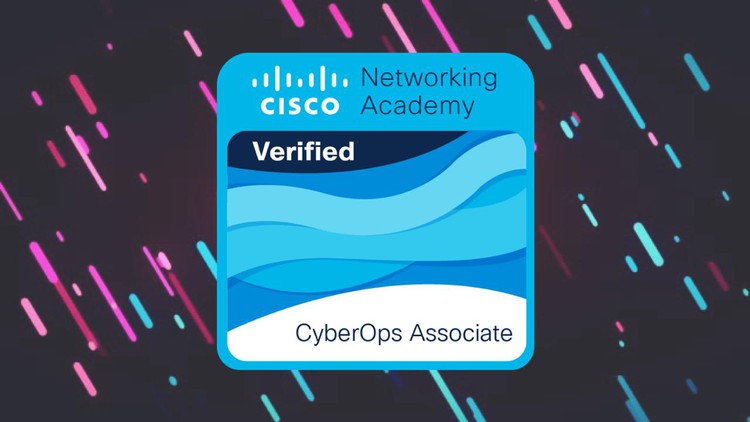
Pass your Cisco CCNA Cyber Ops 200-201 CBROPS Exam fully confident with this exam simulations !
What you will learn
Understanding Cisco Cybersecurity Operations Fundamentals
Test your knowledge before passing the 200-201 CBROPS Exam
Be 100% ready to take the 200-201 CBROPS exam
Full preparation for the 200-201 CBROPS certification exam
Description
Preparing to Understand Cisco CBROPS Cybersecurity Operations Essentials (200-201)? Here, we’ve brought you the best questions from the exam so you can prepare yourself well for this Cisco CBROPS Cybersecurity Operations Fundamentals Understanding (200-201) exam.
Unlike other online simulation practice tests, you get lifetime access to it. You can simply study the questions to excel in this exam.
About Understanding Cisco Cybersecurity Operations Fundamentals 200-201 CBROPS
200-201 CBROPS exam tests a candidate’s knowledge and skills related to security concepts, security monitoring, host-based analysis, network intrusion analysis, and security policies and procedures.
Exam Pattern
- Exam Name: Understanding Cisco Cybersecurity Operations Fundamentals
- Exam Code: 200-201 CBROPS
- Length of Time: 120 Minutes
- Number of Questions: 95-105
- Exam Language: English
Practice Test Structure
1. Security Concepts : 20%
1.1 Describe the CIA triad
1.2 Compare security deployments
1.3 Describe security terms
1.4 Compare security concepts
1.5 Describe the principles of the defense-in-depth strategy
1.6 Compare access control models
1.7 Describe terms as defined in CVSS
1.8 Identify the challenges of data visibility (network, host, and cloud) in detection
1.9 Identify potential data loss from provided traffic profiles
1.10 Interpret the 5-tuple approach to isolate a compromised host in a grouped set of logs
1.11 Compare rule-based detection vs. behavioral and statistical detection
2. Security Monitoring : 25%
2.1 Compare attack surface and vulnerability
2.2 Identify the types of data provided by these technologies
2.3 Describe the impact of these technologies on data visibility
2.4 Describe the uses of these data types in security monitoring
2.5 Describe network attacks, such as protocol-based, denial of service, distributed denial of service, and man-in-the-middle
2.6 Describe web application attacks, such as SQL injection, command injections, and crosssite scripting
2.7 Describe social engineering attacks
2.8 Describe endpoint-based attacks, such as buffer overflows, command and control (C2), malware, and ransomware
2.9 Describe evasion and obfuscation techniques, such as tunneling, encryption, and proxies
2.10 Describe the impact of certificates on security (includes PKI, public/private crossing the network, asymmetric/symmetric)
2.11 Identify the certificate components in a given scenario
3. Host-Based Analysis : 20%
3.1 Describe the functionality of these endpoint technologies in regard to security monitoring
3.2 Identify components of an operating system (such as Windows and Linux) in a given scenario
3.3 Describe the role of attribution in an investigation
3.4 Identify type of evidence used based on provided logs
3.5 Compare tampered and untampered disk image
3.6 Interpret operating system, application, or command line logs to identify an event
3.7 Interpret the output report of a malware analysis tool (such as a detonation chamber or sandbox)
4. Network Intrusion Analysis : 20%
4.1 Map the provided events to source technologies
4.2 Compare impact and no impact for these items
4.3 Compare deep packet inspection with packet filtering and stateful firewall operation
4.4 Compare inline traffic interrogation and taps or traffic monitoring
4.5 Compare the characteristics of data obtained from taps or traffic monitoring and transactional data (NetFlow) in the analysis of network traffic
4.6 Extract files from a TCP stream when given a PCAP file and Wireshark
4.7 Identify key elements in an intrusion from a given PCAP file
4.8 Interpret the fields in protocol headers as related to intrusion analysis
4.9 Interpret common artifact elements from an event to identify an alert
4.10 Interpret basic regular expressions
5. Security Policies and Procedures : 15%
5.1 Describe management concepts
5.2 Describe the elements in an incident response plan as stated in NIST.SP800-61
5.3 Apply the incident handling process (such as NIST.SP800-61) to an event
5.4 Map elements to these steps of analysis based on the NIST.SP800-61
5.5 Map the organization stakeholders against the NIST IR categories (CMMC, NIST.SP800 61)
5.6 Describe concepts as documented in NIST.SP800-86
5.7 Identify these elements used for network profiling
5.8 Identify these elements used for server profiling
5.9 Identify protected data in a network
5.10 Classify intrusion events into categories as defined by security models, such as Cyber Kill Chain Model and Diamond Model of Intrusion
5.11 Describe the relationship of SOC metrics to scope analysis (time to detect, time to contain, time to respond, time to control)
Heads up:
*We do not offer real exam questions, we provide learning material and practice tests designed to help students prepare for these exams. All certification marks used are the property of the respective brand owners. I cannot or claim any ownership of any of the marks.